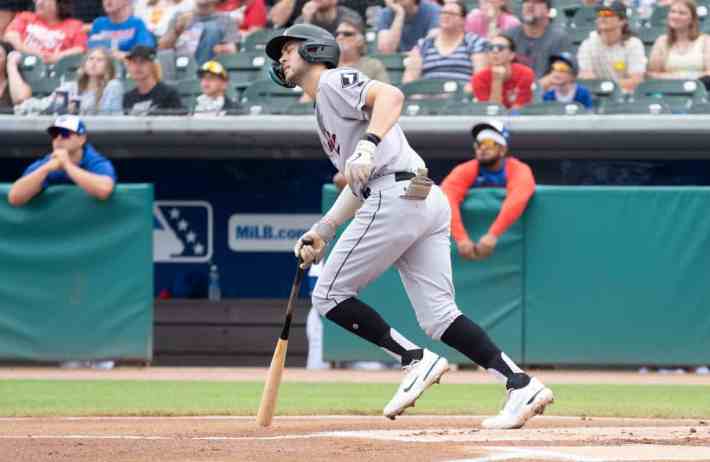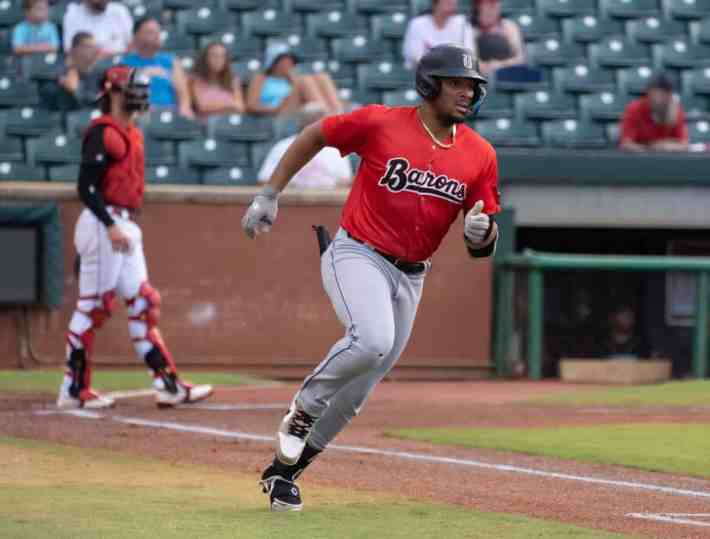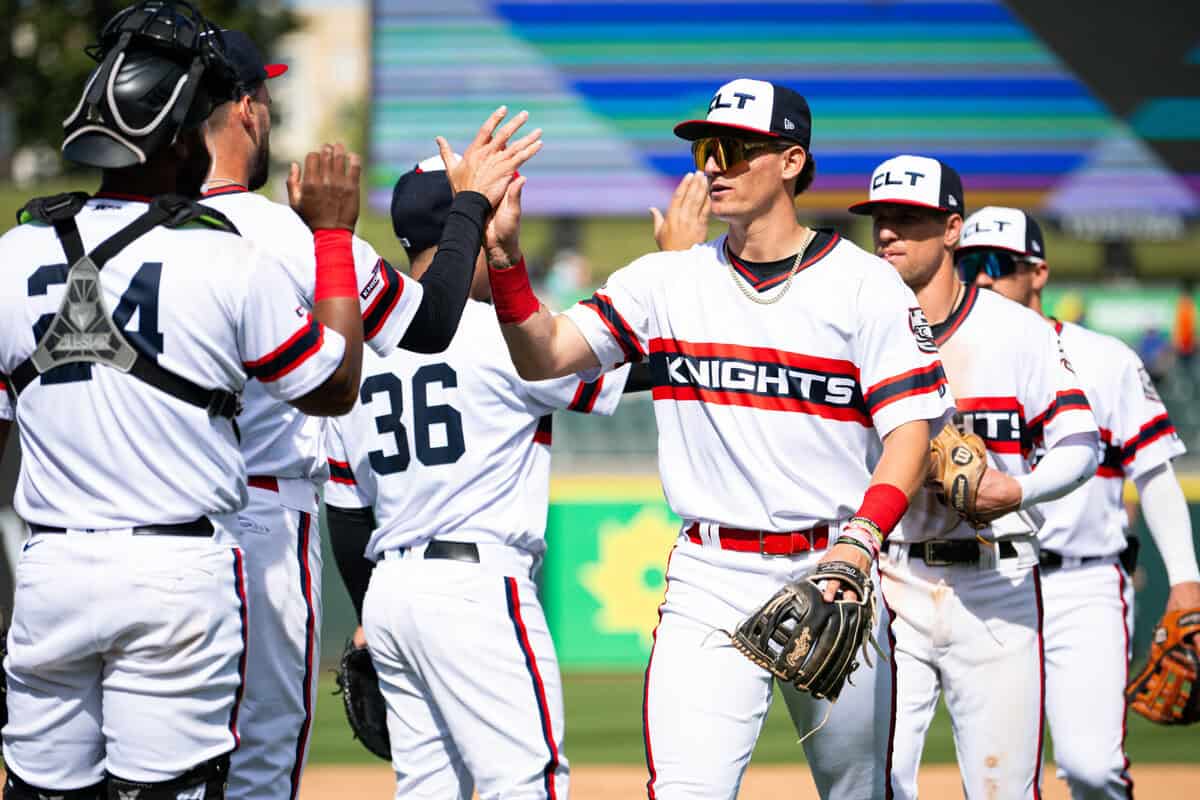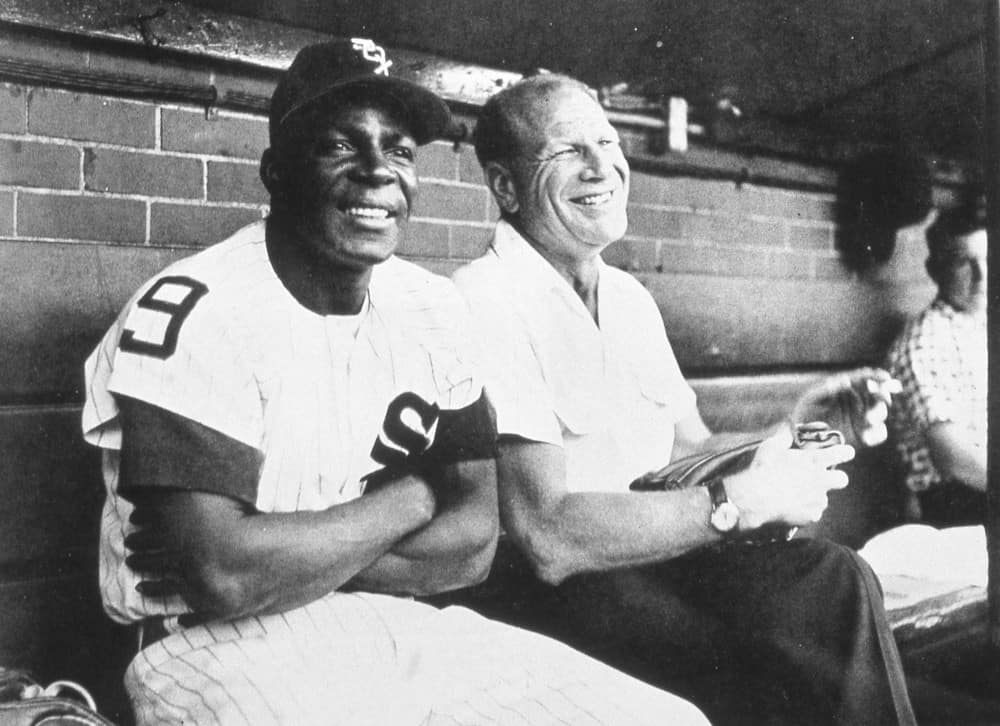On the eve of the publication of our top 10 White Sox prospects lists, it's time to look at the cases that offer the most to digest.
The first four installments of Prospect Week all were simpler in nature. There were the White Sox prospects who would need at least another year to know their deals, the prospects who just reached professional baseball, the prospects who dealt with a season-shifting injury, and the prospects who did all they could in 2024.
The final baker's dozen prospects have all been at it long enough to know what gaps are left to close, and for those watching to develop some hunches about whether that sort of correction is within reach.
Colson Montgomery: Zone coverage
Cue up a clip reel of every fastball thrown to Montgomery in the upper third of the strike zone last year, and you’ll see enough whiffs to concede it’s an intractable issue. The counterpoint is that Mongtomery’s long hoped for plus power matured while his larger offensive game suffered, such that the contact he did make on elevated velocity went far enough that he slugged .596 on upper third fastballs. By year’s end, Montgomery was conceding what coaches and scouts had been suggesting, that he had grown bigger and bulkier, and his swing and leg load needed to shrink correspondingly to stay on time. If knowing is half the battle, Montgomery has plenty of pop to take advantage if his chase rates restore to his old norms, and he’s still at shortstop; even if being bigger and slower than normal at that spot is an issue too. If the demonstrated limitations in Montgomery’s plate coverage from last year have carryover, a homer-and-walks diet paired with shortstop defense a tick below average could still produce a regular, but not a savior.
Bryan Ramos: A defining tool
Ramos accrued 108 MLB plate appearances and gained US citizenship in 2024, so it wasn’t anything close to a lost year, but there wasn’t an area of his game that took a convincing step forward. He’s still athletic for a third baseman and has decent plate discipline components, but he still has some holes in the zone, still has errors of overzealousness in the field, and now he has to worry about crowding at third base. He’ll turn 23 in March, a fine age to be on the cusp of the 26-man roster, but depending on what comes of the White Sox’s fascination with Miguel Vargas and Montgomery’s ultimate defensive home in the infield, he might be the odd man out at his primary position. At least he’s fast enough to play an outfield corner, so if the bat comes around, the Sox should be able to figure out ways to get him on the field.

Ky Bush: In-season stamina
White Sox personnel talk about Bush like it’s 2003. Inverted vertical break, approach angle and supination bias get shelved in favor of straight fastball velocity. Coming off a 2023 campaign marred by lat troubles, Bush came out of the gate sitting 93-95 mph, and his fastball beat barrels to the spot enough to set up a host of secondaries. As he sputtered to the close of a career-high in innings and ended the year on the injured list with tricep soreness, Bush was struggling to 89-92 mph, and a geyser of walks erupted as he tried to account for the loss in potency. A healthy version of Bush was stride-for-stride with many of the arms now ahead of him in competition for the major league rotation, but sustaining more than 124 innings of high quality work will be a requirement for holding down a spot.
Wikelman Gonzalez: Control
Gonzalez’s strike-throwing abilities took a step forward from the first half of his 24 games with Double-A Portland (14.9 percent walk rate, 9 HBPs over 39⅔ innings) to his second (10.2 percent walk rate, 1 HBP over 44 innings). The catch is that many of those games were shorter outings, and all of them were on extra rest, which is how he ended up with only 83 ⅔ innings in 2024 after throwing 210 innings over the previous two seasons combined. He said that he was focused on improving his conditioning this winter in order to hold his gains over a heavier workload, and the White Sox will give him a chance to show what he can do before resigning him to the relief role that seems more probable. Either course is enough to make him interesting as the fourth player in the Garrett Crochet return.
Jairo Iriarte: Fastball
Coveted for his “hyper-mobility,” and the funky angles and “upshoot” fastballs it enabled, Iriarte arrived in the White Sox system drifting so newly rigid and upright in his delivery that his four-seamers played as sinkers. Such is the 23-year-old Venezuelan’s raw talent, the Sox would note, that he churned out 126 quality innings at Double-A regardless. But the what to heck nature of his transformation means that Iriarte is on the 40-man roster, has burned through an option year and made his big league debut, but Ethan Katz finds himself working on a different project than what was anticipated for what was always a raw prospect with considerable relief risk.

Jacob Gonzalez: Mechanics
Gonzalez capped an end of season chat by reasoning “for being uncomfortable the whole year, I’ve done pretty good in my eyes,” and said so while in the midst of installing a leg kick that keyed a big showing in the Southern League playoffs. He didn’t make the statement cynically. Gonzalez had overhauled his posture in the box over the offseason to straighten out his direction and achieved his goal, but lost feel for his loading action in the process. In this view, Gonzalez’s offseason work on his leg kick is just the next step in his journey toward his ideal swing, and his in-progress swing produced a strikingly high amount of contact. With roughly average raw power and capable defense at short, that’s the foundation of a good prospect. It’s just that Gonzalez was a proven SEC performer, and after his first full pro season is sitting on a .327 career slugging percentage.
Nick Nastrini: Mechanics
Nastrini threw 120 innings between Charlotte and Chicago, but too many of them were in Charlotte, and too many of them were hard to watch. He issued 88 walks – 36 over 35⅔ innings with the White Sox – and some of those control issues stemmed from starting the year compromised by pneumonia, and some of it coming from pitching nervously while encountering jams more often than not. He worked on his back leg, he worked on his tempo, and for a four-start stretch at the end of August, it appeared that he’d regained the form that made him the White Sox’s second-most interesting pitching prospect last year. Then he walked six Orioles over 1⅔ innings and threw just 30 of 72 pitches for strikes. Perhaps a cleaner, healthier start of the season will prevent the kind of snowballing that buried him last year, but a move to the bullpen should be in their back pocket, and ready to play in short order.

Wilfred Veras: Plate discipline
Despite his very aggressive approach and his tendency to hit more grounders than advised, Veras hadn’t really experienced any form of prolonged failure in professional baseball until 2024. He hit .363/.379/.571 over his first five series, but the 31-to-2 strikeout-to-walk ratio showed that he was the same old Veras, and an eight-team league makes it harder to outrun the scouting reports. Over the 66 games that followed, Veras hit .212/.259/.343 with 72 strikeouts over 266 plate appearances, and he hit into 10 doubles plays against 18 extra-base hits. He had enough bat-to-ball talent to avoid prolonged 0-fers, but it was mostly singles.
By the end of the season, Veras was able to recapture a little bit of intrigue. He not only pulled out of his nosedive over the final two months (.310/.389/.474), but he drew 20 walks in August and September, after totaling just 16 through July. Was this surge in his walk rate the result of hard-earned gains, or was Veras more comfortable after starting on his second season of Double-A experience at a time where High-A arms were being promoted after the draft? Both are entirely possible, and given that he didn't turn 22 until November and the White Sox didn't lose him in the Rule 5 draft, there's at least one more year to watch it unfold. For comparison, DJ Gladney is four months older than Veras, but has only played 40 games in Birmingham, and production around his strikeouts has been a taller order. Gladney has the edge in defense, and he provided the championship-winning walk-off single for the Barons, so those are two things going for him.
Juan Carela: Power
For the most part, Carela’s game is already built around the notion that power will remain elusive. He throws his low-80s sweeper a plurality of the time, and is preparing to wield a trio of fastball shapes given that none of them are touting outlier velocity or movement. With such a spin-heavy approach, Carela’s walk avoidance is already commendable and his 106⅔ innings of 3.71 ERA fueled enough confidence in his ability to stick in a rotation to earn a 40-man roster spot this winter. As it currently stands, Carela has a puncher’s chance to mature into a back-end, kitchen sink righty. He touched 95 mph at points with his four-seamer last year and stands a lean six-foot-three, but even if the reasons to dream on more projection aren’t more fleshed out than that, Carela is at a point where a nudge toward league average velocity could alter his trajectory.

Prelander Berroa: Control
Troubled by shoulder discomfort last spring, Berroa took a while to ratchet all the way up to pairing a pretty hoppy 99 mph heater with a hellish high-80s two plane breaker. Time soon proved that was too much stupid muscle for Triple-A hitters to contend with, and–provided he was within the general area–major leaguers too through most of the final six weeks of the season. Being much more precise than the general area of the strike zone seemed like too much to ask for Berroa in 2024. Throwing 99 mph is hard and his delivery doesn’t try to convince you otherwise. Berroa is on his fourth organization and has been in professional ball since 2017, so the way his torso wrenches drastically to the first base side is the product of a lot of work to smooth things out to this degree. But he won’t turn 25 until April and a dip to simply the 9-12 percent walk rate range will make him a leverage arm and a July trade chip.
Jake Eder: Control
It’s been too many years now since Eder’s Tommy John surgery rehab was complete to keep holding a torch for the mid-to-upper 90s velocity that made him dominant in the lower minors to return. Realistically, that concretely lowers the ceiling for what was always a stuff-over-command prospect, and not being able to dominate with velocity ratchets up the difficulty level everywhere else. Eder can spin it, but his breaking stuff is filled with too many uncompetitive misses for that to take charge over his arsenal. The White Sox and Brian Bannister have been focusing a lot of Eder’s changeup, which he’s always shown better ability to command, even when the slider’s movement made it the headliner offering. Eder raved about his newfound comfort with the seam shifted changeup that Bannister taught him, but a subsequent promotion to Triple-A revealed it to be not enough to maintain control of the zone, as he walked 27 batters in 34 ⅔ innings at Charlotte and didn’t look more polished in a Chicago bullpen cameo. At age 26, it’s nearing time to figure out what path turns Eder into a contributor before his options are exhausted.
Tanner McDougal: Arsenal
When McDougal and Peyton Pallette both struggled to transition from pitching four innings once a week in Kannapolis to five innings every five games in Winston-Salem, the White Sox chose different paths. The Sox put Pallette in the bullpen, where he became a projectable relief prospect almost immediately. McDougal, 21, returned to the Kannapolis rotation with mixed results, although he finished the year with five no-hit innings against Fredericksburg in the Game 2 of the Carolina League Championship Series. (McDougal got the win, but because it was a postseason game, his B-Ref page still shows an 0-11 record between the two levels). Based on McDougal’s inexperience when the White Sox drafted him out of high school in 2019 and the torn UCL at the end of the 2021 season, it should be more exciting that he’s been able to throw 43 starts without incident the past two years, but with a fastball that plays below its velocity, there’s a reason why the Sox haven’t seen the bullpen as an equally quick fix.






